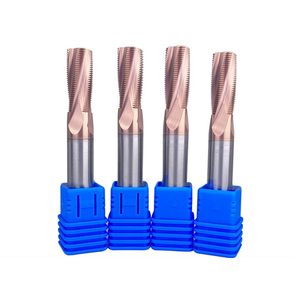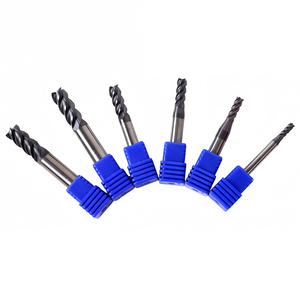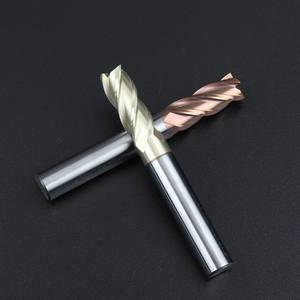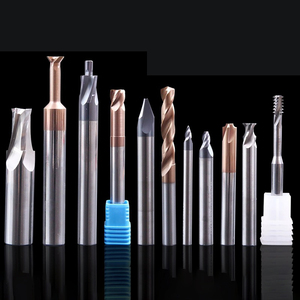
All categories
Featured selections
Trade Assurance
Buyer Central
Help Center
Get the app
Become a supplier

(6252 products available)














































Rough milling cutters provide the intense cutting power that’s necessary for the rapid stock removal on metals and heavy-duty materials. Because of this, they’re associated with a long life and are often made from several alloys that’re both strong and tough. Below are the common types.
Face mill roughing cutters cut materials at the face of the cutter body. This means that a face mill cutter will remove materials relatively plane to the direction of milling. They come in flat and stepped designs. Flat face mills are preferred for their high metal removal rate (MMR). They’re used on CNC lathes primarily, but they can still be found on manual lathes in machine shops in developing countries.
An end mill cutter is a tool with cutting teeth located at the end as well as on the sides of the nominal cylindrical cutter. Because of this design, it can be used to mill flat surfaces, profiles, cavities, and vertical walls. Both roughing end mills and regular end mill cutters can be used as face mill roughing cutters. However, it’s more common to find end mill cutters used in a CNC milling machine.
Slab milling cutters, also known as slab mills, are wide and flat cutters that machine big flat areas of workpieces. They’re often used to machine large finishes and thus require high MRRs, cutting power, and cutter life. Slab milling cutters are mostly used in horizontal type CNCs due to the orientation of the cutter, although they can still be used on manual vertical lathes. They come in various widths, ranging from 25mm to over 400mm.
As the name suggests, ball nose cutters have rounded nose ends. The end mill cutters have square cutter ends, whereas ball nose cutters have rounded end mill cutting ends. This design enables the tool to make radius bottom slots and concave surfaces. It’s also great at machining 3D shapes.
Roughing end mill cutters are used in a few industrial applications. Below, discover where they mostly remove material in:
The aerospace industry requires a reliable cutter that will work with the tough materials common in this space. From titanium alloys to heavy-duty aluminum, the industry needs to mill these materials quickly and efficiently, while also extending cutter life. These are the qualities that rough cutters provide. This industry uses face mill cutters, slab mill cutters, and end mill cutters for various applications, including:
The marine industry embodies an environment of high moisture concentration, which is a recipe for corrosion. It also uses variable-depth water-cooling vessels, which expose the cutter to thermal shocks that lead to cracking and damage. It’s, therefore, paramount for this industry to have milling cutters that are tough enough to endure the harsh elements. Apart from the special coatings, which provide corrosion resistance, rough milling cutters give the industry long life and good productivity. The marine industry uses them in:
The medical industry uses face mill cutters, slab mills, and end mill cutters to make medical devices and equipment, such as surgical implants and tools. It also mills intricate components that require high precision. The industry works with tough materials, such as cobalt chrome and titanium, which require face mill cutters and end mill cutters for efficient roughing. Cobalt chrome and titanium alloys are biocompatible materials, meaning they can be implanted in the body without causing adverse effects. These materials are tough and durable and are often used in long-term medical solutions. However, they’re also hard to mill, which is why they require durable and efficient cutters like roughing end mill cutters. The industry also faces the challenge of ensuring that the cutter can withstand sterilization processes, so cuters with proper disinfections and sterilization can endure rough service are preferred.
Rough end mill cutters have different technical characteristics that make them ideal for various machining applications across industries. Below are the key specifications.
The diameter of the cutter has a significant influence on the end mill's performance. The larger the diameter size, the higher the rigidity, which increases the cutter's ability to withstand axial and radial forces. It also increases the MMR and width of the cut. Conversely, the smaller the diameter, the better the end mill's ability to make detailed cuttings. It will take a slower time to cut, and it won't generate as much heat.
The number of flutes influences the MMR as well as the rigidity. An end mill with more flutes will have fewer chances of breaking, which will make it more robust. It also increases the area for chip removal, thus enhancing the cutter's MMR capability. Conversely, the number of flutes won't be as powerful, and the end mill cutter will be less robust. However, it allows for better chip removal, which aids cooling and minimizes clogging of materials.
End mill roughing cutters are made of either high-speed steel (HSS), HSS with cobalt for enhanced toughness, and carbide. HSS and cobalt HSS are strong but not as tough, so they mill materials that aren't as hard of a challenge. Carbide is much stronger, so it can mill materials that are tougher and endure more heat.
The coating of the roughing cutter provides the much-needed hardness, which reduces friction, protects against chemical interaction, and makes the cutter much stronger. Common materials of the coating are TiN, which reduces friction; TiAlN, which provides much stronger protection against abrasion and oxidation; and CrN, which protects against corrosion.
Some important factors to consider when purchasing milling cutters for end mills. Below are the factors to consider for choosing roughing end mill cutters.
End mill cutters are made from high-speed steel (HSS) or carbide. HSS is robust and doesn't shatter; thus, it's suitable for tough materials that aren't hard, such as bronze and copper. Coated HSS, which has added cobalt, makes it tougher and better for the higher temperatures encountered when milling tougher steels and nickel alloys. Carbide-end mill cutters are ideal for when machining titanium, stainless steel, and other hard materials. They hold sharp edges longer than HSS and can tolerate the heat generated when milling harder materials.
Generally, cutter diameters range from 1/8 to 2 inches. In end mills, smaller-diameter cutters are ideal for milling intricate details and cuts. At the same time, larger-diameter heftier cutters are suited for stock removal on the workpiece flat areas. Larger diameter cutters are also more robust and suitable for high MMRs, although they aren't good for detailed machining. This makes the newly arrived cutter diameter a vital factor to consider when purchasing end mill cutters to help avoid purchasing one unsuitable for the intended project.
The material of the workpiece to be milled determines the kind of cutter that should be used. Softer materials like rough end mill cutters made of HSS are preferred. Machining nonferrous materials like aluminum and copper also calls for carbide-coated HSS cutters. On the other hand, tougher and harder materials like stainless steel and titanium require strong end mill cutters of carbide.
The flute design influences chip removal and cutter efficiency. Flutes with more (up to five) numbers are robust but will cause more resistance during cutting. Thus, they are good for chip removal at higher rates. Conversely, fewer-fluted end mills are strong but have fewer chip removal areas. They suit machining softer materials.
A. The choice between the two depends on the nature of the work to be done. A roughing end mill is designed for rapid material removal. Its teeth are wide and powerful, enabling it to hog away large amounts of material quickly and efficiently. On the other hand, a ball nose end mill is designed for more finished and detailed work. Its rounded end is ideal for creating contoured surfaces, pockets, and 3D shapes.
A. No. There are special finishing end mills that are designed for this purpose. Finishing end mills are meant to provide the smoothest cut possible and are used for final passes on a workpiece to provide a good surface finish.
A. The right speed will depend on several factors, such as the material being milled and the diameter of the cutter, and also the type of machine. As a general rule, though, the RPMs should typically be in the range of 100 to 1,000 RPM per inch of cutter diameter.
A. They are designed to quickly remove large amounts of material from a workpiece. They make milling large portions of materials fast and efficiently. Their face teeth cut large pieces of materials. The teeth are also tough enough to handle hard and soft materials. Common workpieces that roughing end mill cutters are used on are molds and dies for industrial applications, aerospace parts, and automotive components.